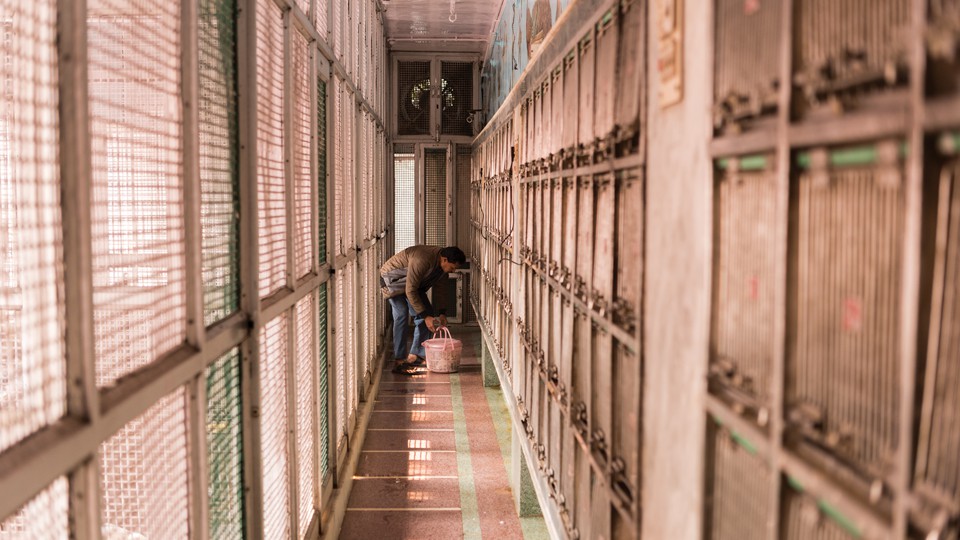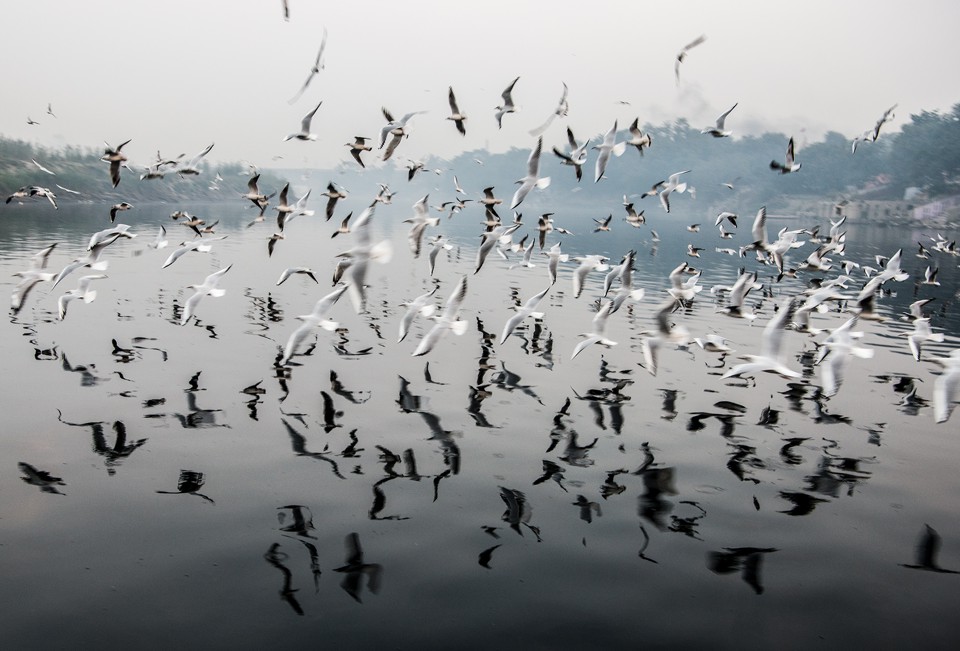theatlantic.com, by Ross Andersen [30-40 minutes].
On a hot day last spring, I removed my shoes at the hospital’s entrance and walked up to the second-floor lobby, where a clerk in his late 20s was processing patients. An older woman placed a shoebox before him and lifted off its lid, revealing a bloody white parakeet, the victim of a cat attack. The man in front of me in line held, in a small cage, a dove that had collided with a glass tower in the financial district. A girl no older than 7 came in behind me clutching, in her bare hands, a white hen with a slumped neck.
The hospital’s main ward is a narrow, 40-foot-long room with cages stacked four high along the walls and fans on the ceiling, their blades covered with grates, lest they ensnare a flapping wing. I strolled the room’s length, conducting a rough census. Many of the cages looked empty at first, but leaning closer, I’d find a bird, usually a pigeon, sitting back in the gloom.
The youngest of the hospital’s vets, Dheeraj Kumar Singh, was making his rounds in jeans and a surgical mask. The oldest vet here has worked the night shift for more than a quarter century, spending tens of thousands of hours removing tumors from birds, easing their pain with medication, administering antibiotics. Singh is a rookie by comparison, but you wouldn’t know it from the way he inspects a pigeon, flipping it over in his hands, quickly but gently, the way you might handle your cellphone. As we talked, he motioned to an assistant, who handed him a nylon bandage that he stretched twice around the pigeon’s wing, setting it with an unsentimental pop.
The bird hospital is one of several built by devotees of Jainism, an ancient religion whose highest commandment forbids violence not only against humans, but also against animals. A series of paintings in the hospital’s lobby illustrates the extremes to which some Jains take this prohibition. In them, a medieval king in blue robes gazes through a palace window at an approaching pigeon, its wing bloodied by the talons of a brown hawk still in pursuit. The king pulls the smaller bird into the palace, infuriating the hawk, which demands replacement for its lost meal, so he slices off his own arm and foot to feed it.

Jains move through the world in this gentle way because they believe animals are conscious beings that experience, in varying degrees, emotions analogous to human desire, fear, pain, sorrow, and joy. This idea that animals are conscious was long unpopular in the West, but it has lately found favor among scientists who study animal cognition. And not just the obvious cases—primates, dogs, elephants, whales, and others. Scientists are now finding evidence of an inner life in alien-seeming creatures that evolved on ever-more-distant limbs of life’s tree. In recent years, it has become common to flip through a magazine like this one and read about an octopus using its tentacles to twist off a jar’s lid or squirt aquarium water into a postdoc’s face. For many scientists, the resonant mystery is no longer which animals are conscious, but which are not.
No aspect of our world is as mysterious as consciousness, the state of awareness that animates our every waking moment, the sense of being located in a body that exists within a larger world of color, sound, and touch, all of it filtered through our thoughts and imbued by emotion.
Even in a secular age, consciousness retains a mystical sheen. It is alternatively described as the last frontier of science, and as a kind of immaterial magic beyond science’s reckoning. David Chalmers, one of the world’s most respected philosophers on the subject, once told me that consciousness could be a fundamental feature of the universe, like space-time or energy. He said it might be tied to the diaphanous, indeterminate workings of the quantum world, or something nonphysical.
These metaphysical accounts are in play because scientists have yet to furnish a satisfactory explanation of consciousness. We know the body’s sensory systems beam information about the external world into our brain, where it’s processed, sequentially, by increasingly sophisticated neural layers. But we don’t know how those signals are integrated into a smooth, continuous world picture, a flow of moments experienced by a roving locus of attention—a “witness,” as Hindu philosophers call it.

This notion that consciousness was of recent vintage began to change in the decades following the Second World War, when more scientists were systematically studying the behaviors and brain states of Earth’s creatures. Now each year brings a raft of new research papers, which, taken together, suggest that a great many animals are conscious.
It was likely more than half a billion years ago that some sea-floor arms race between predator and prey roused Earth’s first conscious animal. That moment, when the first mind winked into being, was a cosmic event, opening up possibilities not previously contained in nature.
There now appears to exist, alongside the human world, a whole universe of vivid animal experience. Scientists deserve credit for illuminating, if only partially, this new dimension of our reality. But they can’t tell us how to do right by the trillions of minds with which we share the Earth’s surface. That’s a philosophical problem, and like most philosophical problems, it will be with us for a long time to come.
Apart from Pythagoras and a few others, ancient Western philosophers did not hand down a rich tradition of thinking about animal consciousness. But Eastern thinkers have long been haunted by its implications—especially the Jains, who have taken animal consciousness seriously as a moral matter for nearly 3,000 years.
Many orthodox Jain beliefs do not stand up to scientific scrutiny. The faith does not enjoy privileged access to truth, mystical or otherwise. But as perhaps the world’s first culture to extend mercy to animals, the Jains pioneered a profound expansion of the human moral imagination. The places where they worship and tend to animals seemed, to me, like good places to contemplate the current frontier of animal-consciousness research.

“A few days after the crow arrived, it started using a special call when it wanted food,” Singh said. “None of the other birds do that.” The bird’s call was not an entirely unique case of bird-to-human communication. A grey parrot once amassed a 900-word vocabulary, and in India, a few have been trained to recite the Vedic mantras. But birds have only rarely assembled verbal symbols into their own, original proto-sentences. And, of course, none has declared itself conscious.
That’s too bad, because philosophers tend to regard such statements as the best possible evidence of another being’s consciousness, even among humans. Without one, no matter how long I stared into the crow’s black pupil, wishing I could see into the phantasmagoria of its mind, I could never really know whether it was conscious. I’d have to be content with circumstantial evidence.
Crows have an unusually large brain for their size, and their neurons are packed densely relative to other animals’. Neuroscientists can measure the computational complexity of brain activity, but no brain scan has yet revealed a precise neural signature of consciousness. And so it’s difficult to make a knockdown argument that a particular animal is conscious based strictly on its neuroanatomy. It is suggestive, though, when an animal’s brain closely resembles ours, as is the case with primates, the first animals to be knighted with consciousness by something approaching a scientific consensus.

Crows are among the most sophisticated avian technologists. They have long been known to shape sticks into hooks, and just last year, members of one crow species were observed constructing tools out of three separate sticklike parts. In Japan, one crow population has figured out how to use traffic to crack open walnuts: The crows drop a nut in front of cars at intersections, and then when the light turns red, they swoop in to scoop up the exposed flesh.
As Singh and I talked, the crow grew bored with us and turned back to the window, as though to inspect its faint reflection. In 2008, a magpie—a member of crows’ extended family of corvids, or “feathered apes”—became the first non-mammal to pass the “mirror test.” The magpie’s neck was marked with a bright dot in a place that could be seen only in a mirror. When the magpie caught sight of its reflection, it immediately tried to check its neck.
Singh told me this crow would soon move upstairs, to one of the roof’s exposed cages, where the birds have more space to test their still-fragile wings, in view of an open sky that must surely loom large in a bird’s consciousness. With luck, it would quickly return to the spirited life preferred by wild crows, which sometimes play like acrobats in high winds and ski down snowy surfaces. (Birds that die at this hospital are buried along a riverbed outside Delhi, an apt touch in the case of the crows, which sometimes hold funerals—or, if not funerals, postmortems, where they gather around their dead like homicide detectives discerning cause of death.)
I asked Singh how he felt when he released birds on the rooftop. “We are here to serve them,” he said, and then noted that not all the birds leave right away. “Some of them come back and sit on our shoulders.”

If these behaviors add up to consciousness, it means one of two things: Either consciousness evolved twice, at least, across the long course of evolutionary history, or it evolved sometime before birds and mammals went on their separate evolutionary journeys. Both scenarios would give us reason to believe that nature can knit molecules into waking minds more easily than previously guessed. This would mean that all across the planet, animals large and small are constantly generating vivid experiences that bear some relationship to our own.
The day after I visited the bird hospital, I left Delhi by car, on a road that follows the Yamuna River south and east, away from its icy source among the serrated ridges of the Himalayas. Delhi’s sewage has blackened long stretches of the Yamuna, making it one of the world’s most polluted rivers. From the road, I could see plastic bottles floating on its surface. In India, where rivers have a special place in the spiritual imagination, this is a metaphysical defilement.
Millions of fish once swam in the Yamuna River, before it was desecrated by the human technosphere, which now reaches into nearly every body of water on Earth. Even the deepest point in the ocean is littered with trash: A grocery bag was recently seen drifting along the bottom of the Mariana Trench.
We last swam in the same gene pool with the animals that evolved into fish about 460 million years ago, more than 100 million years before we split from birds. The notion that we are kin across this expanse of time has proved too radical for some, which is one reason the ever-changing universe described by Darwin has been slow to lodge in the collective human consciousness. And yet, our hands are converted fins, our hiccups the relics of gill-breathing.
Scientists have sometimes seemed to judge fish for their refusal to join our exodus out of the water and into the atmosphere’s more ethereal realm of gases. Their inability to see far in their murky environment is sometimes thought to be a cognitive impairment. But new evidence indicates that fish have minds rich with memories; some are able to recall associations from more than 10 days earlier.
They also seem to be capable of deception. Female trout “fake orgasms,” quivering as though they’re about to lay eggs, perhaps so that undesired males will release their sperm and be on their way. We have high-definition footage of grouper fish teaming up with eels to scare prey out of reefs, the two coordinating their actions with sophisticated head signals. This behavior suggests that fish possess a theory of mind, an ability to speculate about the mental states of other beings.
A more troubling set of behaviors has emerged from experiments designed to determine whether fish feel pain. One of the most intense states of consciousness, pain is something beyond the mere detection of damage. Even the simplest of bacteria have sensors on their external membranes; when the sensors detect trace amounts of dangerous chemicals, the bacteria respond with a programmed flight reflex. But bacteria have no central nervous system where these signals are integrated into a three-dimensional experience of the chemical environment.

Such actions call the ethics of the research itself into question. But the experiences of lab fish are nothing compared with those endured by the trillions of aquatic animals that humans yank, unceremoniously, out of oceans and rivers and lakes every year. Some fish are still alive, hours later, when they’re shoveled into the sickly lit, refrigerated intake tubes of the global seafood supply chain.
Fish pain is something different from our own pain. In the elaborate mirrored hall that is human consciousness, pain takes on existential dimensions. Because we know that death looms, and grieve for the loss of richly imagined futures, it’s tempting to imagine that our pain is the most profound of all suffering. But we would do well to remember that our perspective can make our pain easier to bear, if only by giving it an expiration date. When we pull a less cognitively blessed fish up from the pressured depths too quickly, and barometric trauma fills its bloodstream with tissue-burning acid, its on-deck thrashing might be a silent scream, born of the fish’s belief that it has entered a permanent state of extreme suffering.
The Jains tell a story about Neminath, a man from deep antiquity who is said to have been sensitive to the distress calls of other animals. He developed his unusual fondness for animals while tending cattle in pastures on the banks of the Yamuna River, in his home village of Shauripur, which I reached four hours after leaving Delhi.
Neminath is one of 24 Jain “Fordmakers,” prophetlike figures who crossed a metaphorical river, freeing themselves from the cycle of birth and rebirth, before showing others the way to enlightenment. The Fordmakers’ life stories tend to emphasize their nonviolent natures. One is said to have floated perfectly still in the womb, sending not so much as a ripple through the amniotic fluid, to avoid harming his mother.
Only a few Fordmakers are confirmed historical figures, and Neminath is not one of them. The Jains say Neminath left his village for good on the day of his wedding. That morning, he mounted an elephant, intent on riding it to the temple where he was to be wed. On the way, he heard a series of agonized screams, and demanded to know their origin. Neminath’s elephant guide explained that the screams came from animals that were being slaughtered for his wedding feast.
This moment transformed Neminath. Some versions of this story say he freed the surviving animals, including a fish that he carried, in his hands, back to the river. Others say he fled. All agree that he renounced his former life. Rather than marry his bride, he set out for Girnar, a sacred mountain in Gujarat, 40 miles from the Arabian Sea.

The trail was only 50 miles from Gir National Park, where, the day before, I’d seen two Asiatic lions, nearly indistinguishable cousins of Africa’s lions. Once the region’s apex predator, the Asiatic lion almost went extinct during the British empire’s colonization of India, when no viceroy could visit a maharaja’s palace without a hunt in the local forest. Even today, the Asiatic lion still ranks among the rarest of the large feline predators, rarer even than its neighbor to the north, the snow leopard, which is so scarce that a glimpse of one padding down a jagged Himalayan crag is said to consummate a spiritual pilgrimage.
I did my best to put the lions, which have recently expanded to Girnar’s forests, out of my mind as I passed small huts and tents in the dark, at the trail’s base. Daylight brought langur monkeys onto the trailside boulders. One watched a vendor set up his stall to offer food and water to passing Jain pilgrims. The monkey waited until the man’s back was turned, at which point he scampered in to grab a banana. In Gir National Park, I’d seen deer using these monkeys as a treetop surveillance system. The monkeys sat high in the trees, keeping watch for leopards and lions, which blend into the woodland’s pre-monsoon palette of amber and gold. Monkeys that spotted a stalking cat let out a specific call. Deer weren’t the only ones that recognized and used these calls; the lion tracker who had been with me in the park did too.
On the hike up Girnar, barefoot women kept passing me, wearing iridescent saris in bright shades of orange, green, or pink. Their delicate silver anklets tinkled as they went. When I reached a trail marker that said I was still 1,000 steps from the temple, I removed my pack and hopped up onto a wall, letting my legs dangle.

The monk and I had the trail to ourselves for a moment. All was silent but for a buzzing sound that I traced to a spindly black wasp bobbing above a dense clump of bougainvillea. The last ancestor this wasp and I shared likely lived more than 700 million years ago. The insect’s appearance reinforced this sense of evolutionary remoteness. The elongated shape and micro-tiled matte finish of its eyes made it seem too alien to be conscious. But appearances can deceive: Some wasps are thought to have evolved large eyes to observe social cues, and members of certain wasp species can learn the facial features of individual colony members.
Wasps, like bees and ants, are hymenopterans, an order of animals that displays strikingly sophisticated behaviors. Ants build body-to-body bridges that allow whole colonies to cross gaps in their terrain. Lab-bound honeybees can learn to recognize abstract concepts, including “similar to,” “different from,” and “zero.” Honeybees also learn from one another. If one picks up a novel nectar-extraction technique, surrounding bees may mimic the behavior, causing it to cascade across the colony, or even through generations.
In one experiment, honeybees were attracted to a boat at the center of a lake, which scientists had stocked with sugar water. When the bees flew back to the hive, they communicated the boat’s location with waggle dances. The hive’s other bees would usually set out immediately for a newly revealed nectar lode. But in this case, they stayed put, as though they’d consulted a mental map and dismissed the possibility of flowers in the middle of a lake. Other scientists were not able to replicate this result, but different experiments suggest that bees are capable of consulting a mental map in this way.
Andrew Barron, a neuroscientist from Macquarie University, in Australia, has spent the past decade identifying fine neural structures in honeybee brains. He thinks structures in the bee brain integrate spatial information in a way that is analogous to processes in the human midbrain. That may sound surprising, given that the honeybee brain contains only 1 million neurons to our brains’ 85 billion, but artificial-intelligence research tells us that complex tasks can sometimes be executed by relatively simple neuronal circuits. Fruit flies have only 250,000 neurons, and they too display complex behaviors. In lab experiments, when faced with dim mating prospects, some seek out alcohol, the consciousness-altering substance that’s available to them in nature in broken-open, fermenting fruit.
Many invertebrate lineages never developed anything beyond a rudimentary nervous system, a network of neurons dispersed evenly through a wormlike form. But more than half a billion years ago, natural selection began to shape other squirming blobs into arthropods with distinct appendages and newly specialized sensory organs, which they used to achieve liberation from a drifting life of stimulus and response.
The first animals to direct themselves through three-dimensional space would have encountered a new set of problems whose solution may have been the evolution of consciousness. Take the black wasp. As it hovered above the bougainvillea’s tissue-thin petals, a great deal of information—sunlight, sound vibrations, floral scents—rushed into its fibrous exoskull. But these information streams arrived in its brain at different times. To form an accurate and continuous account of the external world, the wasp needed to sync these signals. And it needed to correct any errors introduced by its own movements, a difficult trick given that some of its sensors are mounted on body parts that are themselves mobile, not least its swiveling head.
The neuroscientist Björn Merker has suggested that early animal brains solved these problems by generating an internal model of the world, with an avatar of the body at its center. Merker says that consciousness is just the multisensory view from inside this model. The syncing processes and the jangle and noise from our mobile bodies are all missing from this conscious view—some invisible, algorithmic Stanley Kubrick seems to edit them out. Nor do we experience the mechanisms that convert our desires into movements. When I wished to begin hiking up the mountain again, I would simply set off, without thinking about the individual muscle contractions that each step required. When a wasp flies, it is probably not aware of its every wing beat. It may simply will itself through space.
If one of the wasp’s aquatic ancestors experienced Earth’s first embryonic consciousness, it would have been nothing like our own consciousness. It may have been colorless and barren of sharply defined objects. It may have been episodic, flickering on in some situations and off in others. It may have been a murkily sensed perimeter of binary feelings, a bubble of good and bad experienced by something central and unitary. To those of us who have seen stars shining on the far side of the cosmos, this existence would be claustrophobic to a degree that is scarcely imaginable. But that doesn’t mean it wasn’t conscious.

The monk was a white dot some six switchbacks up by the time I hopped off the wall and continued the climb, my legs stiffened by the break. I reached the entrance to the temple complex with only 15 minutes to spare. Its marble courtyard shone brilliant white, as though bleached by the mountain sun.
Ducking under a row of elegant golden medallions, I entered the temple’s interior chamber, where dozens of candles flickered in intricately carved wall niches, and on platforms that hung from the ceiling on chains. The stone ceiling was carved into a lotus flower, its delicate unfurling petals symbolizing the emergence of a pure, ethereal soul from the Earth’s muddy materials.

Forty
Jains were sitting on the floor in neat rows, their legs crossed in the
lotus position. The women wore fresh saris they’d carried up the
mountain for the occasion. The men were dressed in all white. I wedged
into a spot in the back.
We faced a dark, tunnel-like space lined
by two sets of columns. At the far end, candlelight illuminated a black
marble statue of a seated male figure. Its barrel chest was inlaid with
gemstones, as were its eyes, which appeared to float, serenely, in the
dark space, inducing a hypnotic effect, broken only when the man sitting
next to me tugged my shirt. “Neminath,” he said, nodding toward the
statue.
It was here on this mountain that Neminath is said to have
achieved a state of total, unimpeded consciousness, with perceptual
access to the entire universe, including every kind of animal mind.
Jains believe that humans are special because, in our natural state, we
are nearest to this experience of enlightenment. Among Earth’s
creatures, no other finds it so easy to see into the consciousness of a
fellow being.
The pilgrims started singing, first in a low hum and
then steadily louder. One wheeled a giant drum next to the tunnel’s
entrance and struck it with a dark mallet. Two others bashed cymbals
together. Men and women walked in from opposite doors, converging, in
two lines, on either side of the tunnel. A woman wearing an orange sari
and a gold crown crossed in front of Neminath, lifted a vessel over his
black-marble head, and poured out a mixture of milk and blessed water.
When she finished, a white-robed man from the other line did the same.
The
singing grew louder until it verged on ecstatic. The pilgrims raised
their arms and clapped overhead, faster and faster. A climax seemed to
loom, but then it all dropped away. The drums and the bells and the
cymbals went quiet, leaving a clear sonic space that was filled by a
final blow on a conch.
The shell’s low note was long and clean. It
rang out of the temple and over the ancient peaks. As it trailed off, I
wondered whether, in the centuries to come, this place might become
something more than a Jain house of worship. Maybe it will become a
place to mark a moment in human history, when we awakened from the dream
that we are the only minds that nature brought into being. Maybe people
will come here from all corners of the Earth to pay their respects to
Neminath, who is, after all, only a stand-in for whoever it was who
first heard animal screams and understood their meaning.
This article appears in the March 2019 print edition with the headline “What the Crow Knows.”
Nenhum comentário:
Postar um comentário